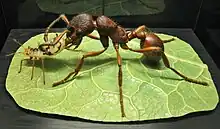
Alfred Keller (1902–1955) was a German museum artist who created large models of insects and other small animals; these models are unique for their impressive attention to detail.
Keller was employed at the Museum für Naturkunde (Museum of Natural History) in Berlin, Germany from 1930 until his death in 1955, and his sculptures can still be found there.[1] He worked with papier-mâché and several other materials such as celluloid and galalith to create models of insects including a flea (1930, 100:1 scale), a housefly (1932, 50:1 scale), a mosquito in flight (1937, 60:1 scale), a Colorado potato beetle (1940, 50:1 scale), and a ball bearer leafhopper (Bocydium globulare, 1953, 180:1 scale), among others. The housefly, typical of the painstaking attention to detail shown in Keller's sculptures, includes 2,653 bristles. Each model took about a year to complete.[2]
Works
 flea (1930, 100:1 scale)
flea (1930, 100:1 scale) housefly (1932, 50:1 scale)
housefly (1932, 50:1 scale) mosquito in flight (1937, 60:1 scale)
mosquito in flight (1937, 60:1 scale) Wheat weevil (1940, 50:1 scale)
Wheat weevil (1940, 50:1 scale) Myrmica rubra with Aphid, 1944, 100:1 scale, 1947 reconstruction of a model destroyed in World War II
Myrmica rubra with Aphid, 1944, 100:1 scale, 1947 reconstruction of a model destroyed in World War II ball bearer treehopper (Bocydium globulare, 1953, 180:1 scale)
ball bearer treehopper (Bocydium globulare, 1953, 180:1 scale)
References
- ↑ "Keller's Insect Models". Museum für Naturkunde. 2019-04-23. Retrieved 2019-10-30.
- ↑ Kemp, Martin (2010). "Sculpture: Terrible wonder". Nature. 468 (7323): 506–507. Bibcode:2010Natur.468..506K. doi:10.1038/468506a. ISSN 0028-0836.
External links
- German webpage including a photo of two of Keller's insect sculptures.
- Nature article about Alfred Keller (subscription required)
- Blog post containing a photograph of Keller's ball bearer leafhopper